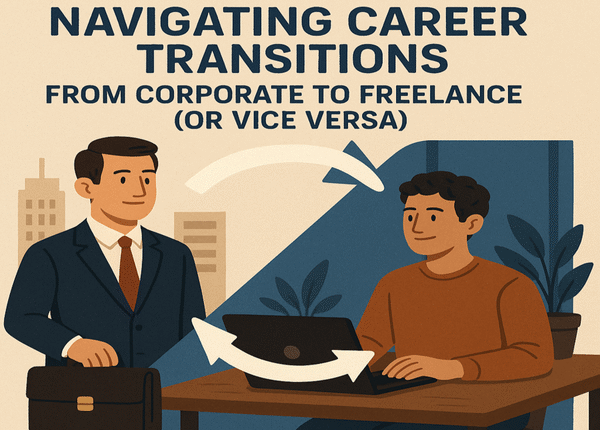🛤 Navigating Career Transitions: From Corporate to Freelance (or Vice Versa)
Thinking of trading your 9-to-5 for freedom—or swapping gig work for structure? You’re not alone. More professionals are reevaluating their career paths, especially post-pandemic. Whether you’re leaping into freelance life or rejoining the corporate world, the transition isn’t always easy—but it’s absolutely doable with the right mindset, a few tools, and solid preparation.
In this guide, we’ll walk through practical steps, mindset shifts, and strategies to help you confidently switch tracks and build credibility in your new world.
🎯 1. Know Why You’re Making the Switch
Before updating your resume or setting up a freelance portfolio, get clear on your why. Are you seeking flexibility, better pay, growth opportunities, or a healthier work-life balance?
Self-reflection prompts:
- What do I value most in my work?
- What am I running from—and what am I running toward?
- Am I financially and emotionally prepared for this transition?
✅ Tip: Clarity on your goals will guide every decision you make, from branding to networking.
🧠 2. Mindset Matters: Expect a Shift in Culture and Pace
Moving from corporate to freelance—or freelance to full-time—can feel like stepping into a different universe.
From Corporate to Freelance:
You’re now your own boss, marketer, project manager, and accountant. You’ll face:
- Uncertainty: Clients come and go.
- Freedom: You set your hours and pick projects.
- Responsibility: There’s no IT desk or HR to help.
“It took me six months to stop panicking every time a client ghosted me,” says Joseph Kim, a former tech project manager turned freelance strategist. “But I learned to build a pipeline and trust the process.”
From Freelance to Corporate:
You’ll need to re-adjust to:
- Team structures
- Office politics
- Longer feedback loops
“After five years freelancing, I had to remind myself how to navigate meetings, corporate lingo, and even Excel again,” laughs Natalie Wanjiru, now an operations lead at a fintech startup.
🧰 3. Rebrand Yourself Authentically
Whether you’re joining the freelance world or stepping back into full-time employment, you’ll need to position yourself differently.
🔄 From Corporate to Freelance:
You’re no longer just “Marketing Manager, XYZ Ltd.” You’re now the go-to expert for a specific problem.
💡Update these:
- LinkedIn headline (use keywords!)
- Personal website or portfolio
- Freelance platforms (e.g., your CareerSafi profile)
🧭 From Freelance to Corporate:
Hiring managers might view your freelance stint as a “gap”—unless you frame it as a strategic, skill-building choice.
✅ Do this:
- Package freelance roles as consulting engagements
- Use metrics: “Helped 12 clients grow organic traffic by 300%”
- Highlight adaptability and self-discipline
🌐 4. Build (or Rebuild) Credibility
New arenas require new credibility. The key? Social proof, visibility, and real results.
For Freelancers:
- Collect client testimonials.
- Share mini case studies on LinkedIn or your portfolio.
- Network in niche communities (Reddit, Discord, LinkedIn groups, CareerSafi forums).
For Job Seekers:
- Get endorsements on LinkedIn.
- Request recommendation letters from freelance clients.
- Use storytelling in your cover letter to highlight how your freelance experience adds value.
📷 Visual Idea: A side-by-side profile comparison—before and after rebranding for a freelance/employee role.
📚 5. Upskill With Purpose
One of the best ways to stay competitive is to never stop learning. Identify what skills are trending in your new path—and jump in.
In-Demand Freelance Skills for 2025:
| Category | Skills to Learn | Where to Learn |
|---|---|---|
| Tech | Web dev, Python, no-code tools, AI automation | Coursera, Udemy |
| Marketing | SEO, copywriting, email funnels, branding | Skillshare, HubSpot Academy |
| Design | Figma, UX/UI, motion graphics | Dribbble Learn, LinkedIn Learning |
| Data & AI | Excel, Power BI, prompt engineering | DataCamp, OpenAI Learn |
| Business | Freelance management, negotiation, taxes | Teachable |
🔄 6. Keep Evolving: Freelancing and Corporate Aren’t Enemies
Some of the most successful professionals switch back and forth between freelance and full-time across their careers. And that’s perfectly okay.
In fact:
- Companies increasingly value entrepreneurial experience.
- Freelancers often return to jobs with higher pay and senior roles.
- Hybrid careers (e.g., consulting + part-time role) are becoming the norm.
💬 “I freelance during the week and teach digital marketing on weekends,” says Aisha Otieno, a Kenyan-based creative strategist. “This combo gives me income stability and creative fulfillment.”
💼 7. Join a Platform That Supports Your Journey
Whether you’re seeking projects or hiring talent, platforms like CareerSafi.com help make transitions smoother.
🌟 On CareerSafi, you can:
- Showcase your freelance services or apply for jobs.
- Browse client reviews and project scopes.
- Get matched with roles that align with your background.
🔗 Sign up now to post a job, apply as a freelancer, or explore talent.
🚀 Final Thoughts: Your Next Chapter Starts With One Step
Career transitions are rarely clean or easy. But with intentional branding, smart learning, and a mindset tuned for growth, you can build a path that’s truly yours.
Wherever you’re headed next—freelance freedom or corporate clarity—remember: this is your career, and there’s no wrong way to own it.


